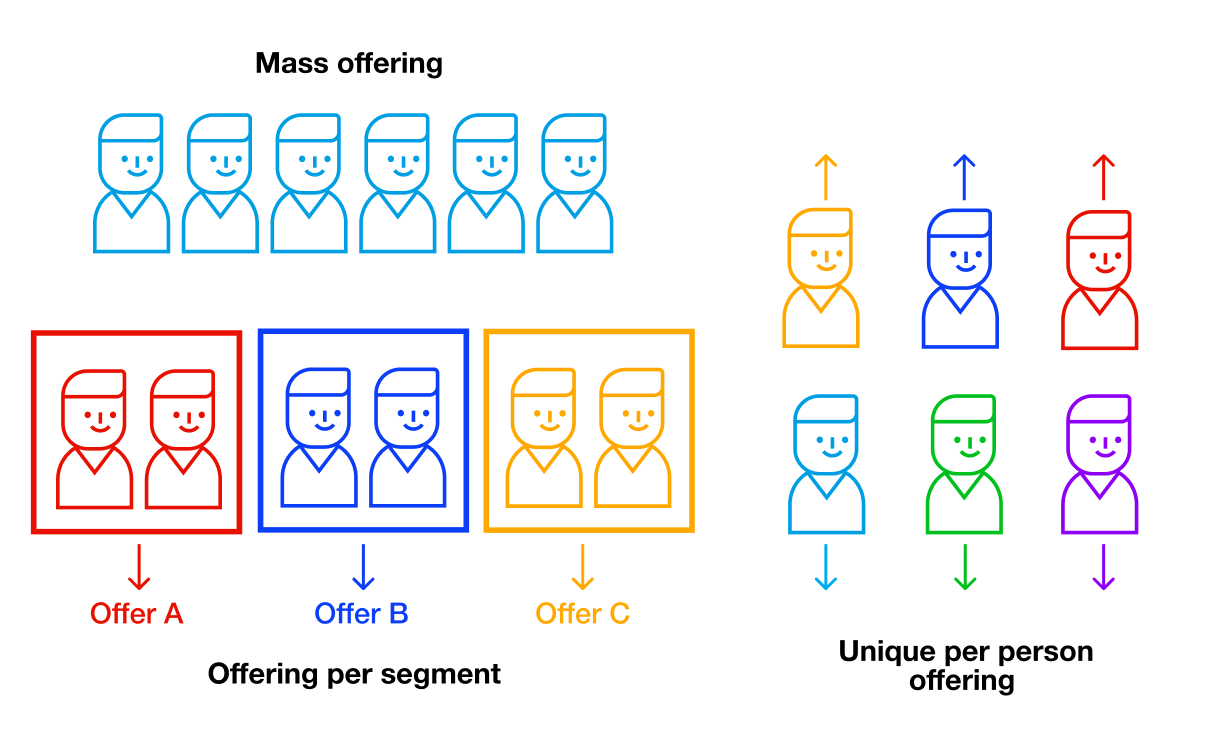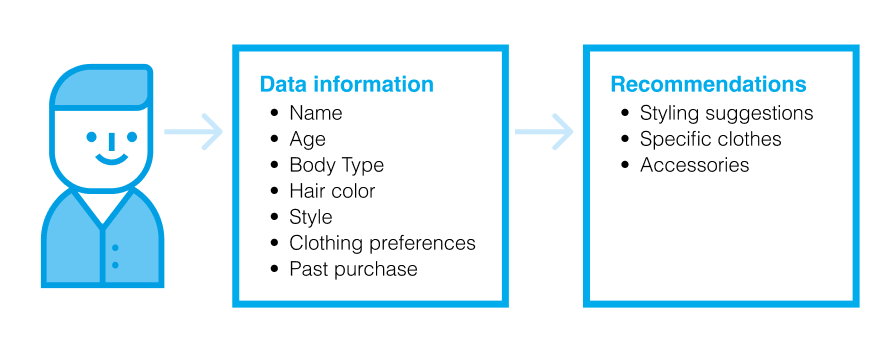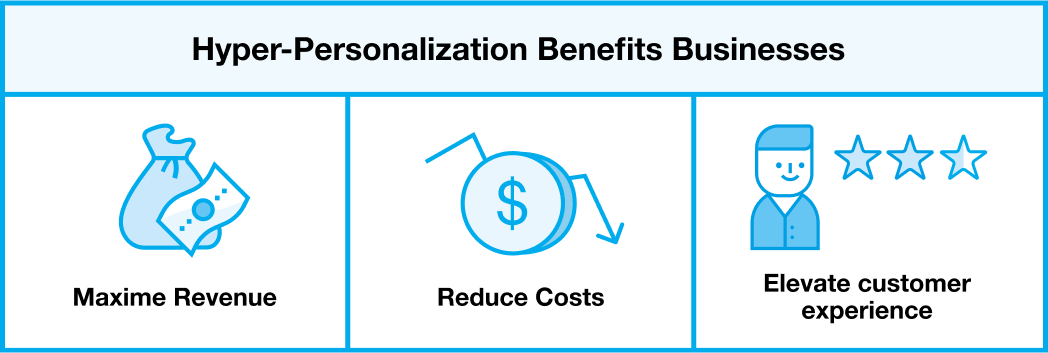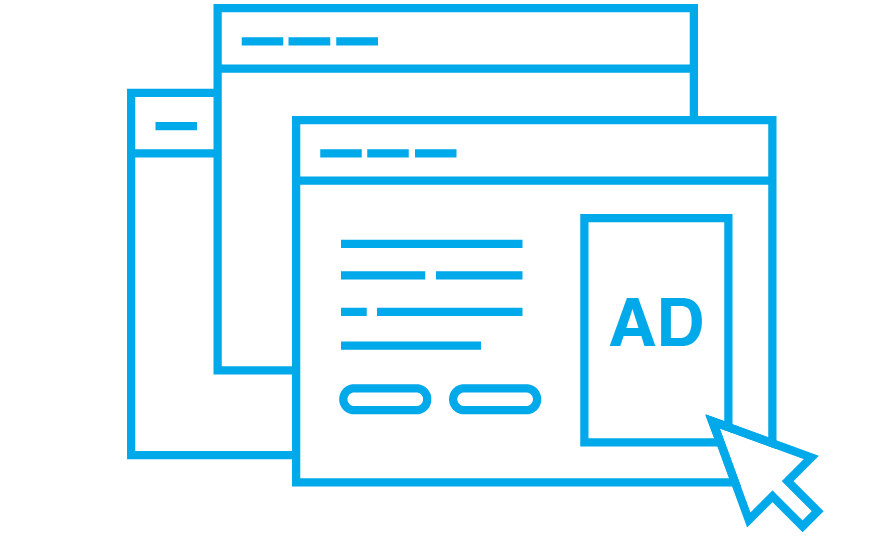- The Evolution of Personalization
- What Is Hyper-Personalization?
- How Does Hyper-Personalization Work?
- Why Is Hyper-Personalization needed?
- Why is data the fuel to hyper-personalization?
- What Are The Key Elements of Hyper-Personalization Strategy?
- What Is An Example of Hyper-Personalization?
- What Industries Can Apply Hyper-Personalization with a Positive ROI?
- How Hyper-Personalization Can Help Businesses?
- How Can OnAudience Help With Hyper-Personalization?
In today’s fast-paced digital landscape, where customers are bombarded with countless marketing messages, standing out and capturing their attention has become more challenging than ever. That’s where hyper-personalization comes into play. It’s not just about addressing customers by their first names; it’s about going above and beyond to understand their unique preferences, needs, and behaviors.
By leveraging the power of data, analytics, and AI, businesses can create tailored experiences that make customers feel valued and understood. Hyper-personalization is the secret sauce that not only improves the customer experience but also fosters long-term loyalty and drives business growth. In this age of high customer expectations, adopting a hyper-personalized marketing strategy is no longer a luxury but a necessity to be ahead of competition.
The Evolution of Personalization
The evolution of personalization in marketing has witnessed a significant shift from mass communication to targeted segmentation and now to hyper-personalization. In the past, businesses relied on mass communication strategies to reach a wide audience with the same marketing message. However, as customer expectations evolved, marketers realized the need to tailor their approach to specific segments of the market.
Segmentation became popular as it allowed businesses to categorize consumers into groups based on geographic, demographic, psychographic, and other types of data. This approach enabled more targeted marketing efforts, leading to increased sales and reduced marketing costs. However, as technology advanced and customer demands became more individualized, segmentation alone was no longer sufficient.
Enter the era of personalization, where marketing efforts shifted towards tailoring experiences for individual customers. Personalization strategies utilized behavioral, demographic, and geographic data to provide specific, tailored consumer experiences. This approach recognized the unique preferences and needs of each customer, enhancing customer satisfaction and loyalty .
Today, with the rise of the digital age and the COVID-19 pandemic forcing businesses to adapt, hyper-personalization has emerged as the next frontier in marketing.
Hyper-personalization goes beyond traditional segmentation and leverages data, analytics, and AI to create highly customized experiences for individual customers. It involves delivering personalized content, personalized email marketing, targeted product recommendations, and more. By understanding customers at a granular level and adapting to their changing realities, businesses can improve the customer experience and stay competitive in a rapidly changing market.
What Is Hyper-Personalization?
Hyper-personalization is an advanced marketing strategy that goes beyond segmentation and uses artificial intelligence (AI) and machine learning to create customized experiences for individual customers.
It involves delivering personalized messages, at the right time and through the right channel, based on real-time data and customer preferences. This approach utilizes big data, AI technologies, and predictive analytics to provide exceptional customer experiences that resonate with each individual.
By leveraging a vast amount of data and advanced algorithms, businesses can offer customized content, personalized email marketing, and targeted product recommendations, leading to improved customer satisfaction and loyalty. Hyper-personalization allows companies to connect with customers on a deeper level and deliver tailored experiences that make them feel valued and understood.

How Does Hyper-Personalization Work?
Hyper-personalization works by leveraging big data, analytics, AI, and automation to create custom and targeted experiences for individual customers. This strategy involves collecting real-time behavioral data from various sources such as social media, browsing history, and purchase history, among others. By analyzing this data, companies can gain a deeper understanding of their customers’ preferences, interests, and needs.
Based on this understanding, they can then tailor their marketing messages and channels to each customer individually. Hyper-personalization goes beyond segmentation by looking into a specific user as a unique entity and providing a more personalized experience, which has been shown to yield positive business results.
Why Is Hyper-Personalization needed?
Hyper-personalization is needed because it allows businesses to create unique and individualized experiences for each customer. In today’s competitive market, customers expect brands to understand their needs and preferences. By leveraging big data, analytics, AI, and automation, businesses can collect real-time behavioral data from various sources and tailor their marketing messages and channels to each customer individually. This strategy goes beyond traditional personalization by delivering highly individualized online experiences that are relevant and contextualized.
- Meeting Customer Expectations – The rise of e-commerce and digital platforms, customers have become accustomed to personalized experiences. They expect businesses to understand their needs, preferences, and desires. Hyper-personalization allows businesses to meet these expectations by tailoring their offerings, recommendations, and communications to each customer’s unique profile.
- Building Stronger Relationships – Personalization fosters a deeper connection between businesses and customers. By providing relevant and timely information, businesses can build trust and loyalty. Hyper-personalization enables businesses to create targeted content, offers, and recommendations that resonate with customers, leading to increased engagement and long-term relationships.
- Enhanced Customer Satisfaction – When customers receive personalized experiences, they feel valued and understood. By delivering relevant and useful content, businesses can enhance customer satisfaction and reduce the chances of customer churn. Hyper-personalization helps businesses deliver the right message to the right customer at the right time, increasing customer satisfaction levels.
Why is data the fuel to hyper-personalization?
Data is considered the fuel to hyper-personalization because it provides the necessary insights and information to create custom and targeted experiences for individual customers. Hyper-personalization leverages big data, analytics, AI, and automation to collect real-time behavioral data from various sources.
This data includes customer preferences, browsing history, purchase patterns, and demographic information. By analyzing this data, businesses can gain a deeper understanding of each customer’s needs, preferences, and behaviors. This enables them to tailor marketing messages, product recommendations, and customer interactions to create unique and individualized experiences. Data is crucial in identifying patterns, predicting future behavior, and delivering personalized content and recommendations that meet customer expectations.
What Are The Key Elements of Hyper-Personalization Strategy?
Hyper-personalization is a powerful marketing strategy that leverages data, analytics, AI, and automation to create unique and targeted experiences for individual customers. The key elements of a hyper-personalization strategy include:
Data Mining – Collecting and analyzing real-time behavioral data from various sources to gain insights into customer preferences and behavior.
Personalized Messaging – Crafting tailored and relevant marketing messages that resonate with individual customers. This involves using customer data to understand their preferences, interests, and needs.
Customized Offers – Personalizing product recommendations, promotions, and pricing based on individual customer preferences and purchase history. This helps to create unique and personalized shopping experiences.
Multi-Channel Approach – Utilizing all available channels, such as email, social media, websites, and mobile apps, to deliver personalized content and engage with customers across different touchpoints.
Timing and Sequencing – Timing campaigns effectively by delivering messages and offers at the right moment in the customer journey to maximize impact and engagement.
Testing and Optimization – Continuously testing and refining different elements of the hyper-personalization strategy to ensure effectiveness and improve customer engagement over time.
These elements enable businesses to create unique and individualized experiences for each customer, improving customer engagement and building stronger relationships.
What Is An Example of Hyper-Personalization?
Here is an example that applies to to the retail industry:
Let’s imagine walking into a clothing store and being greeted by a sales associate who knows your name, style preferences, and even size. As you browse through the racks, you receive personalized recommendations tailored to your taste and previous purchases. When you try on a garment, a virtual mirror shows you how it would look on you, taking into account your body shape and skin tone. At the checkout counter, your payment method is already pre-selected, making the transaction seamless.

This level of hyper-personalization in retail not only enhances the shopping experience but also increases the likelihood of making a purchase. By leveraging customer data and advanced technologies, retailers can create personalized interactions that make customers feel valued and understood. This leads to improved customer satisfaction, increased order conversions, and ultimately, higher revenue.
What Industries Can Apply Hyper-Personalization with a Positive ROI?
Hyper-personalization is a powerful strategy that can be applied across various industries to achieve a positive return on investment (ROI). With hyper-personalization, businesses can gain a competitive edge by delivering highly personalized and targeted experiences that keep them ahead of their competitors.
There are examples of industries that provide a positive ROI such like:
Retail: E-commerce platforms can use hyper-personalization to recommend products based on individual browsing and purchase history, increasing conversion rates and average order value.
Healthcare: Hospitals and clinics can use patient data to personalize treatment plans, improve patient outcomes, and enhance overall patient satisfaction.
Travel: Airlines and hotels can offer personalized travel recommendations, loyalty programs, and tailored promotions based on individual preferences, leading to increased bookings and customer loyalty.
Banking: Financial institutions can provide personalized financial advice, product recommendations, and targeted offers to customers based on their financial goals and spending patterns, resulting in increased customer satisfaction and cross-selling opportunities.
Education: Educational institutions can personalize learning experiences by tracking individual student progress, providing targeted content, and offering personalized feedback, leading to improved academic performance and student engagement.
Automotive: Car manufacturers and dealerships can use customer data to offer personalized vehicle recommendations, customized financing options, and personalized after-sales services, enhancing the overall customer experience and driving repeat purchases.
Entertainment: Streaming platforms can use hyper-personalization to recommend movies, TV shows, and music based on individual preferences, increasing user engagement and subscription retention.
Food and Beverage: Restaurants and food delivery services can personalize menus, offers, and promotions based on individual dietary preferences, past orders, and location, resulting in increased customer satisfaction and repeat purchases.
Fitness: Fitness apps and wearables can use personalized workout plans, nutrition recommendations, and progress tracking to help users achieve their fitness goals, leading to improved user retention and brand loyalty.
Insurance: Insurance companies can offer personalized coverage options, pricing, and policy recommendations based on individual risk profiles and needs, increasing customer satisfaction and policy renewals.
How Hyper-Personalization Can Help Businesses?
Businesses can utilize customer data and analytics to deliver personalized product recommendations and targeted offers that have a higher chance of converting potential customers into paying customers. Furthermore, hyper-personalization allows businesses to customize incentives and offers based on individual customer preferences, reducing unnecessary costs associated with generic marketing campaigns.

Hyper-personalization can help businesses achieve their goals in several ways:
Maximize Revenue:
- By delivering personalized experiences, businesses can increase customer satisfaction, leading to higher conversion rates and repeat purchases.
- Personalized offers and recommendations can drive upsells and cross-sells, increasing the average order value.
- Targeted promotions and discounts can encourage impulse buying and drive revenue growth.
Reduce Costs:
- Hyper-personalization allows businesses to tailor their marketing efforts to specific customer segments, reducing wasted resources on irrelevant campaigns.
- Understanding customer preferences and behavior, businesses can optimize their advertising spend, focusing on channels and messages that resonate with their target audience.
- Automated systems and machine learning algorithms can streamline the personalization process, reducing manual effort and operational costs.
Elevate Customer Experience:
- Personalized marketing messages create a stronger emotional connection with customers, making them feel valued and understood.
- Tailored recommendations and content enhance the overall shopping experience, leading to higher customer satisfaction and brand loyalty.
- By leveraging customer data, businesses can deliver relevant and timely communications across multiple touchpoints, improving customer engagement and retention.
Ultimately, hyper-personalization fosters a deeper sense of connection and loyalty between customers and brands, resulting in increased revenue, reduced costs, and improved customer experience. By utilizing the power of customer data and analytics, businesses can unlock the full potential of hyper-personalization and gain a competitive edge in today’s market.
How Can OnAudience Help With Hyper-Personalization?
OnAudience, a global data provider, fuels analytics systems, platforms and AI algorithms with high-quality data to make it possible for companies that want to take advantage of innovative industry solutions and enable hyper-personalization in their business efforts.
With access to a vast pool of data, businesses can gain comprehensive knowledge about their customers, including their preferences, behaviors, and demographics. This data acts as the foundation for understanding individual customer needs and tailoring marketing campaigns accordingly.
OnAudience helps businesses adjust to the current market needs by offering up-to-date data that can be the fundament of personalized customer journeys and valuable insights. In today’s fast-paced business environment, it is essential to stay agile and adapt quickly to changing trends and customer expectations.
OnAudience’s data-driven approach allows businesses to monitor their target audience’s behavior, identify emerging trends, and make informed decisions based on the most valuable asset – data. By leveraging this valuable information, companies can optimize their marketing strategies, improve customer engagement, and stay ahead of the competition. With OnAudience’s data solutions, businesses can unlock the power of hyper-personalization and deliver personalized experiences that resonate with their customers.



